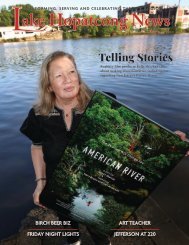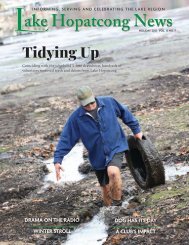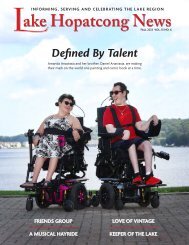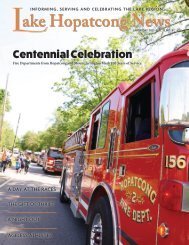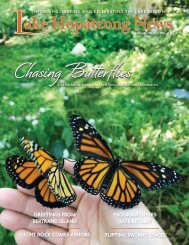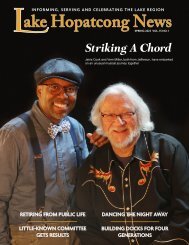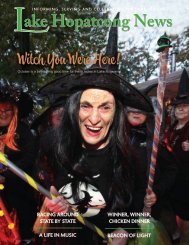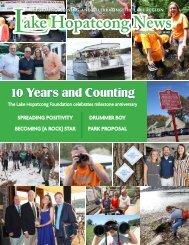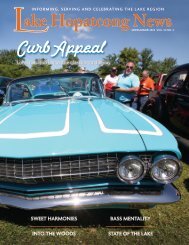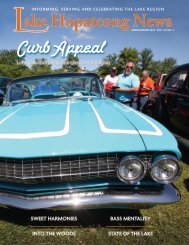Create successful ePaper yourself
Turn your PDF publications into a flip-book with our unique Google optimized e-Paper software.
At Batten the Hatches, She Brings Boatloads of Experience<br />
Story by ELLEN WILKOWE<br />
Photos by Karen Fucito<br />
Maria Pappas of Mine Hill said she has<br />
boarded “thousands and thousands of<br />
boats,” but nearly all of them never actually left<br />
the docks—at least not with her at the helm.<br />
As the owner of Batten the Hatches in Lake<br />
Hopatcong, Pappas refurbishes boats in their<br />
resting states, specifically the interiors that are<br />
in various stages of disrepair.<br />
“I didn’t grow up thinking this is what I wanted<br />
to do with my life,” said the 56-year-old.<br />
Raised in Dover, Pappas was unfamiliar with<br />
nearby Lake Hopatcong until she took a job at<br />
Bill Smith’s Covers after graduating high school.<br />
“I thought that this is a cool thing, working<br />
on the lake,” she said. “It’s a different kind of<br />
job.”<br />
Not to mention, long-lasting. What started<br />
as a summer job turned into a full-fledged<br />
rewarding career, which has lasted 33 years.<br />
Smith’s shop was housed upstairs in what is<br />
now San Bar Marina on Howard Boulevard.<br />
Pappas praised Smith for showing her the<br />
ropes for all matters concerning boat covers,<br />
upholstery, cushions and materials. The seats<br />
and cushions of a boat are fitted with marinegrade<br />
vinyl, she said, while the covers are made<br />
from Sunbrella, an acrylic woven fabric. When<br />
she began, canvas, a natural cotton fiber, was<br />
the only material used to make boat covers. By<br />
the late 1980s, Sunbrella was introduced and<br />
has since become the industry standard for<br />
boat covers.<br />
“I worked for Bob for five years. Then in 1990,<br />
he wanted to move down south. I bought all his<br />
inventory, took over the business and changed<br />
the name,” she recalled.<br />
Being on her own was challenging, she said,<br />
but through trial and error and perseverance<br />
she learned more about the industry and was<br />
able to build her business.<br />
In the process, she also developed a<br />
tough skin, a byproduct of being a female<br />
entrepreneur in a lake environment dominated<br />
by male business owners—and male boat<br />
owners.<br />
“At the beginning it was intimidating,” she<br />
said. “Especially when I was younger—about<br />
30 plus years ago. I’ve held my own, though.”<br />
By 2013, Pappas said she was looking for<br />
a change and sold the business, thinking<br />
she would work instead as a sales rep in the<br />
industry. But circumstances set her on a<br />
different course, and she wound up buying<br />
back the business before the end of the year.<br />
“Within a year of selling it, the person who<br />
bought it realized it wasn’t something he<br />
wanted to do, so I took it back. He was the<br />
one who moved the shop here [at its current<br />
location on 70 Route 181 in Lake Hopatcong]<br />
and it has worked out very well in the end.”<br />
In working alongside Smith, Pappas<br />
awakened a latent passion for working with her<br />
hands, particularly the creative freedom and<br />
satisfaction that comes with witnessing the<br />
start-to-finish process.<br />
“Every day is different,” she said. “Every job is<br />
custom. Some things take longer than others<br />
and it’s challenging at times, but you figure it<br />
out as you go along.”<br />
She credits her team—three full-timers<br />
and one part-timer—for the success of her<br />
business. “I’ve got a good team here,” she said.<br />
“We bounce ideas off each other.”<br />
But a typical day is often atypical. The flow<br />
of work could be as simple as a single seat<br />
cushion or complex as a custom design.<br />
“Some customers drop off cushions and<br />
others leave their entire boat,” she said.<br />
Pappas pounces on the opportunity to<br />
fabricate a custom interior.<br />
A recent custom job included the<br />
upholstering of an American Offshore boat<br />
with black diamond stitching and checkered<br />
racing strips. The diamonds were individually<br />
cut boxes that were stitched together,<br />
Pappas said. The work was recently entered<br />
into a Chesapeake Marine Canvas Fabricators<br />
Association competition, which is held at the<br />
organization’s annual convention, but the<br />
project did not receive an award.<br />
Pappas said the convention is a great place<br />
to learn and meet other shop owners from<br />
around the country.<br />
“There are seminars for people like us who<br />
have been doing this forever. If there’s a<br />
problem, I can call one of those people and say,<br />
‘Hey, I’m in this situation. Have you dealt with<br />
this before?’ It’s a nice community because<br />
where else can you go and learn this stuff?” she<br />
said.<br />
Just recently, shop manager Travis Amico<br />
came away with top honors for his design on<br />
a 1991 HydroStream boat. The colorful striped<br />
pattern was created to mimic the boat’s<br />
geometric design and took first place in Miami<br />
Corporation’s Miami Madness contest. Miami<br />
Corporation is an industry supplier that hosts<br />
a nationwide competition each year.<br />
So, what exactly does it take to custom<br />
design the interior of a boat or reupholster a<br />
comfortable cushion for four?<br />
Well, physical strength, for one, and of course<br />
a boatload of equipment and the deftness<br />
to operate it. Think industrial-sized Consew<br />
sewing machines (circa 1970), staple guns, drills,<br />
pliers and saws, to name a few.<br />
The calorie burn just comes with the<br />
territory.<br />
“At the end of the day you’re exhausted,”<br />
Pappas said. “Between climbing up and down<br />
ladders, in and out of boats, removing and<br />
installing seats…the job is the workout.”<br />
Given the niche of her business, Pappas all<br />
but shrugged off the possibility of competition.<br />
Those who some might consider to be her<br />
competitors she sees as peers.<br />
“There’s not anything detrimental,” she said.<br />
“There’s enough to go around.”<br />
Physicality and competition aside, Pappas<br />
is most challenged by projects that may take<br />
longer than expected due to unanticipated<br />
snags that often come with renovations.<br />
“I may be doing a seat but then I find I have<br />
to drill out this bolt because it’s rusted,” she<br />
said. “All of a sudden you become a carpenter.<br />
You have to cut a piece of wood and a new<br />
piece of vinyl.”<br />
Left to right: Maria Pappas at one of the shop’s<br />
sewing machines. The seat design by Travis<br />
Amico on this 1991 HydroStream boat recently<br />
garnered a first place award. Amico and Pappas<br />
work side-by-side at one of the shop’s large<br />
work benches.<br />
18<br />
LAKE HOPATCONG NEWS <strong>Memorial</strong> <strong>Day</strong> <strong>2023</strong>



